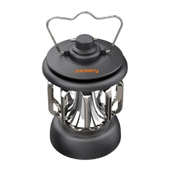For most homeowners, electricity bills are one of the most expensive utilities. The rates have substantially increased in recent years due to extreme weather events and rising utility electricity costs. While the average electricity bill generally varies from household to household, the exact cost will depend on utility rates and consumption habits. The average electricity bill for a 2-person household in the US is around $150 per month with a monthly consumption of 887 kWh.
If you want to reduce the high electricity bill, consider investing in solar-powered generators. For example, the large Jackery Solar Generators have high-capacity batteries that can charge most household appliances for long hours. These solar generators can be recharged from clean and safe energy, helping you reduce the overall high electricity bills. This ultimate guide reveals the average electricity consumption for a 2-person household, factors that affect the bills, and more!
What Is The Average Electricity Bill for a 2-Person Household?
The average electricity bill for a 2-person household in the US is nearly $150 per month with a utility rate of 16.92 cents per kWh and an average monthly consumption of 887 kWh per month. The diagram indicates the average electricity bills according to the data collected from EIA.

The two main reasons for high electricity bills are rate hikes and increased usage. The high electricity bills typically occur in summer when warm weather increases the usage of air conditioners. Many utility rate structures have also changed to TOU (Time of Use) plans. The price of electricity fluctuates throughout the day based on demand. For example, homeowners have to pay an extra amount due to the peak electricity hours compared to non-peak electricity hours.
Here's a table revealing the average electricity bills by state.
|
State |
Energy Rates |
Average Bill (Monthly) |
Monthly Usage (kWh / Per Month) |
|
Utah |
10.44¢ |
$80.24 |
769 |
|
New Mexico |
12.94¢ |
$86.66 |
670 |
|
Colorado |
12.36¢ |
$87.88 |
711 |
|
Illinois |
13.04¢ |
$93.98 |
721 |
|
Idaho |
9.95¢ |
$95.04 |
955 |
|
Washington |
9.87¢ |
$95.72 |
969 |
|
Oregon |
11.17¢ |
$102.32 |
916 |
|
Ohio |
12.29¢ |
$107.30 |
873 |
|
Iowa |
12.46¢ |
$107.78 |
865 |
|
New Jersey |
16.03¢ |
$109.54 |
683 |
|
Michigan |
16.26¢ |
$109.86 |
676 |
|
Arkansas |
10.41¢ |
$110.33 |
1,060 |
|
New York |
18.36¢ |
$110.47 |
602 |
|
Vermont |
19.54¢ |
$110.79 |
567 |
|
Kansas |
12.85¢ |
$113.52 |
883 |
|
Pennsylvania |
13.58¢ |
$114.90 |
846 |
|
Missouri |
11.22¢ |
$115.35 |
1,028 |
|
Louisiana |
9.67¢ |
$116.07 |
1,201 |
|
Kentucky |
10.87¢ |
$116.62 |
1,073 |
|
California |
20.45¢ |
$116.94 |
572 |
|
Delaware |
12.56¢ |
$117.09 |
932 |
|
North Carolina |
11.38¢ |
$118.44 |
1,041 |
|
New Hampshire |
19.04¢ |
$120.01 |
630 |
|
Maryland |
13.01¢ |
$124.50 |
957 |
|
Alaska |
22.57¢ |
$124.66 |
552 |
|
Tennessee |
10.76¢ |
$125.70 |
1,168 |
|
Mississippi |
11.17¢ |
$128.08 |
1,146 |
|
Florida |
11.27¢ |
$128.64 |
1,142 |
|
Georgia |
12.02¢ |
$129.92 |
1,081 |
|
Rhode Island |
22.01¢ |
$130.75 |
594 |
|
Virginia |
12.03¢ |
$131.72 |
1,095 |
|
Massachusetts |
21.97¢ |
$132.18 |
602 |
|
Texas |
11.71¢ |
$132.59 |
1,132 |
|
Arizona |
12.27¢ |
$136.70 |
1,114 |
|
Alabama |
12.57¢ |
$143.95 |
1,145 |
|
Connecticut |
22.71¢ |
$161.55 |
711 |
|
Hawaii |
30.28¢ |
$162.66 |
537 |
Source: EIA
What Factors Affect The Average Electricity Bill for a 2-Person Household?
The average electricity bill for a 2-person household in the US is on the rise. There are many factors that affect household electricity bills, including household size, electricity rates, climate, and energy suppliers.
Newness of the Apartment
Generally, new apartments are more energy-efficient than older ones. This is because new households have slightly better insulation, meaning the heating and cooling efforts are efficient. In addition, new homes have energy-efficient appliances like washers and dryers, LED lights, and refrigerators.
State Electricity Rates
Every state has different electricity rates. For example, Hawaii has an expensive electricity rate, whereas Texas has a cheap electricity rate. You will need to check the electricity rate of your state to calculate the electricity bills.
Climate
Where you live hugely impacts electricity costs. For example, Alaskans spend a lot of money to keep their households warm in winter, whereas Texas uses more power to keep houses cool in summer. Weather events can also influence electricity and energy consumption. Both hot and cold weather can increase the energy price for everybody.

Energy Supplier
The choice of energy supplier can affect average utility costs. Many utility companies and power providers offer fair pricing and freebies to ensure that water heaters and cooling systems do not raise average electricity bills.
As mentioned, electricity bills are increasing with each passing year. One of the best ways to reduce these bills is to invest in Jackery Solar Generators. These solar generators can charge most small and large household appliances, such as refrigerators, ACs, sump pumps, well pumps, coffee makers, and more.
What Uses Most Electricity in a 2-Person Household?
The air conditioning system is the household electrical appliance that consumes the most electricity. The amount of electricity the AC unit consumes will depend on the season and where you live.
If you live in an area that's typically warm year-round, like Florida, Nevada, or Arizona, you will use the AC more frequently. Other household appliances that consume a lot of electricity include space heaters, water heaters, and refrigerators.

How to Calculate an Electricity Bill for a 2-Person Household?
An electricity bill for a 2-person household can be calculated by multiplying the average electricity usage by the electricity rate.
Electricity Bill (in cents) = Monthly Electricity Use × Average Cost Per kWh
Or, Electricity Bill (in dollars) = Monthly Electricity Use × Average Cost Per kWh / 100
If you want to calculate the electricity consumption of each appliance, here's the formula:
Appliance Energy Use = Appliance Power × Time of Use in a Day × 30 (days)
Here's an example,
An average TV draws around 0.030 kW, and an AC uses 3 kW. We assume the appliances run for 10 hours on an average day.
TV: 0.030 kW × 10 H × 30 days = 9 kWh per month
AC: 3 kW × 10 H × 30 days = 900 kWh per month
These prices exclude other expenses you might be paying with the energy bills, such as the TDSP (or Transmission and Distribution Service Provider) flat fee and the Power Provider Flat Fee. The flat fee is typically between $10 and $15.
The total electricity consumption for a 2-person household can be calculated as:
Average Electricity Bill = (Total Cost - Flat Fee) / Total Usage
If the total electricity cost is $50 with a flat fee of $10 and the electricity consumption is 500 kWh, the average electricity bill would be $0.08 per kWh.
If you want to reduce your electricity bills, investing in energy-efficient appliances and Jackery Solar Generators is essential. These generators work using safe and clean energy to generate electricity and charge appliances.

Jackery Solar Generators for 2-Person Household
Solar generators are a good option for a 2-person household as they provide free, renewable energy. These generators are quiet and do not require high maintenance. Jackery is a renowned solar brand manufacturing highly efficient solar generators, solar panels, and power stations.
Here's how they work: Solar energy from the sun falls on the Jackery SolarSaga Solar Panels and gets converted to DC electricity. It is then passed to the Jackery Explorer Portable Power Stations, where the pure sine wave inverter converts DC to AC electricity to charge household appliances.
Jackery Solar Generator 3000 Pro
The large Jackery Solar Generator 3000 Pro has an NMC battery of 3024 Wh, which supports 99% of household appliances. It has pull rods and double wheels, making it easy to move the battery backup from one place to another. This solar generator can be integrated into the home circuits with the Jackery Manual Transfer Switch. You can choose 6 circuits from the home breaker panel, like light switches, refrigerators, and some light outlets.

Customer Review
"Here in Michigan, we are just coming out of the sub-zero temperatures. During this, something happened on the next street, and the power went out. The Jackery powered a heater till the power could come back on." — Alicia Foster.
Jackery Solar Generator 2000 Plus
The large and expandable Jackery Solar Generator 2000 Plus features a LiFePO4 battery of 2 kWh capacity. It is ideal for various scenarios and supports 99% of household appliances. The Jackery Explorer 2000 Plus Portable Power Station takes only 2 hours to be fully recharged with 6*Jackery SolarSaga 200W Solar Panels. The additional Jackery Battery Pack 2000 Plus lets you expand the battery capacity from 2 kWh to 24 kWh.

Customer Review
"Living in the Florida Keys we have to prepare for hurricanes. Irma put us without electricity for 10 days. We needed a solar generator for backup power. Once I gave the equipment a try out for 48 hours we were very happy and felt good about comfortably living through the next bad hurricane." — Steven Holmes.
|
|
||
|
Capacity |
3024 Wh |
2 kWh-24 kWh |
|
Battery Cell |
NMC |
LiFePO4 |
|
Cycle Life |
2000 cycles to 70%+ capacity |
4000 cycles to 70%+ capacity |
|
Dimension |
Length: 18.6 in (47.3 cm) Width: 14.1 in (35.94 cm) Height: 14.7 in (37.36 cm) |
Length: 14.7 in (37.36 cm) Width: 18.6 in (47.3 cm) Height: 14.1 in (35.94 cm) |
|
Recharging Methods |
AC Adapter: 2.4 Hours Car Adapter (12 V): 35 Hours 6*Jackery SolarSaga 200W Solar Panels: 3.5 Hours |
AC Adapter: 2 Hours Car Adapter (12 V): 25 Hours 6*Jackery SolarSaga 200W Solar Panels: 2 Hours |
|
Output Ports |
AC Output (x1): 120 V~ 60 Hz 25 A Max AC Output (x3): 120 V~ 60 Hz 20 A Max USB-A Output (x2): Quick Charge 3.0x2, 18 W Max USB-C Output (x2): 100 W Max, 5 V⎓3 A, 9 V⎓3 A, 12 V⎓3 A, 15 V⎓3 A, 20 V⎓5 A |
AC Output (×4): 120 V~ 60 Hz, 20 A Max, AC Output (×1):120 V~ 60 Hz, 25 A Maximum USB-A Output (x2): Quick Charge 3.0, 18 W Maximum USB-C Output (x2): 100 W Maximum, (5 V, 9 V, 12 V, 15 V, 20 V up to 5 A) |
|
Working Hours |
Space Heater (1500 W): 1.7 H Window AC (1800 W): 1.4 H Clothes Dryer (1500 W): 1.7 H Microwave (1300 W): 1.9 H Dishwasher (250W): 10.2 H Refrigerator (600 W): 4.2 H |
Space Heater (1500 W): 1.1 H Window AC (1800 W): 58 min Clothes Dryer (1500 W): 1.1 H Microwave (1300 W): 1.3 H Dishwasher (250W): 6.9 H Refrigerator (600 W): 2.8 H |
Tips for Saving Electricity Bill for a 2-Person Household
If you think your electricity bills are higher than they should be, there are several tips you can follow to save money.
Invest in Energy-Efficient Appliances
The best way to save more on electricity bills is by investing in energy-efficient household appliances. For example, light bulbs can be replaced with energy-efficient LED bulbs, and a smart programmable thermostat can be installed to automate HVAC appliances and optimize energy consumption. Additionally, switch your heat pump water heater to be more energy-efficient than traditional water heaters.
Unplug Unused Appliances
One easy way to save electricity is by turning lights off when you are not in the room and unplugging appliances that are not in use. This may sound simple but can help you save a lot on electricity bills.
Keep Cooling and Heating of Home to Minimum
Instead of cooling or heating every room in your home, consider controlling the temperature of rooms you are using at a time. This way, you'll use less energy to warm or cool one or two rooms in the apartment.

Time of Use Rate Plans
Some utility companies charge according to the Time of Use (TOU) rate plans, meaning electricity rates will be higher during peak hours. To reduce your overall electricity bill, use heavy-duty appliances like washers and dryers early in the morning or late at night.
Install a Smart Thermostat
Cooling and heating the space can account for a large portion of your electricity bill. Installing a smart thermostat can reduce your overall electricity bills by turning on the HVAC system only when necessary. It works by adjusting temperatures during unoccupied hours to significantly reduce energy consumption.
Use Solar Energy
Consider investing in Jackery Solar Generators, which are designed to supply safe and clean electricity to most household appliances. These solar generators combine Jackery Explorer Portable Power Stations and Jackery SolarSaga Solar Panels to generate clean electricity from free solar energy. Whether you want to live off the grid or reduce some of your electricity bills, these solar generators can help.

Average Electricity Bill for 2-Person Household FAQs
How much electricity does a two-person household use?
The average electricity consumption for a two-person household in the US is 887 kWh per month. However, electricity consumption will vary depending on the region, climatic conditions, etc. According to the EIA, electricity consumption is generally lower in the Northwest and East, where the climatic conditions are moderate. The South and Midwest have humid summers and require nonstop use of AC, leading to higher utility bills.
What is the average cost of electricity per month in Florida?
On average, Florida residents spend around $225 per month or $2700 per year on electricity. The average electricity rate in Florida is 16 cents per kWh (kilowatt-hour). Florida's electricity bills are higher because the state uses natural gas and resources to generate most of its electrical energy. The higher prices of natural gas directly lead to increased electricity costs. Additionally, Florida experiences harsh weather like tropical storms and hurricanes, which can damage utility grids and even increase the use of AC during heat waves.
What is the average cost of utilities in Michigan?
The total average cost of utilities in Michigan is around $413, according to data obtained from organizations like the Energy Information Administration, the Bureau of Labor Statistics, and Energy.gov. Here's a table revealing the average cost of different utilities in Michigan.
|
Utility |
Average Costs in Michigan |
|
Energy bill |
$117.57 |
|
Monthly water bill |
$29 |
|
Internet |
$30 |
|
Natural gas |
$74 |
|
Phone bill |
$114 |
|
Streaming |
$48.50 |
How much electricity does a 2000 sq. ft. house use?
The average monthly electricity usage of a 2000 sq. ft. house in Texas is nearly 1000 - 2000 kWh. However, the average monthly usage will depend on the location, heating and cooling systems, insulation, and weather. Here is the table revealing the power consumption of houses of different sizes.
|
Home Size (sq. ft) |
Estimated Monthly kWh Usage |
|
2,000 |
1,000 – 2,000 kWh |
|
2,500 |
1,250 – 2,500 kWh |
|
3,000 |
1,500 – 3,000 kWh |
|
3,500 |
1,750 – 3,500 kWh |
Final Thoughts
The average electricity bill for a 2-person household depends on various factors, including climatic conditions, utility rates, and household sizes. The rising utility rates and extreme weather conditions lead to increased electricity bills. If you want to reduce the overall electricity consumption, consider investing in Jackery Solar Generators.
They use solar panels to produce clean electricity and charge appliances to run for long hours. The Jackery Solar Generator 3000 Pro and Jackery Solar Generator 2000 Plus are whole-home solar generators that can charge 99% of household appliances and reduce high electricity bills.





















































































































Leave a comment